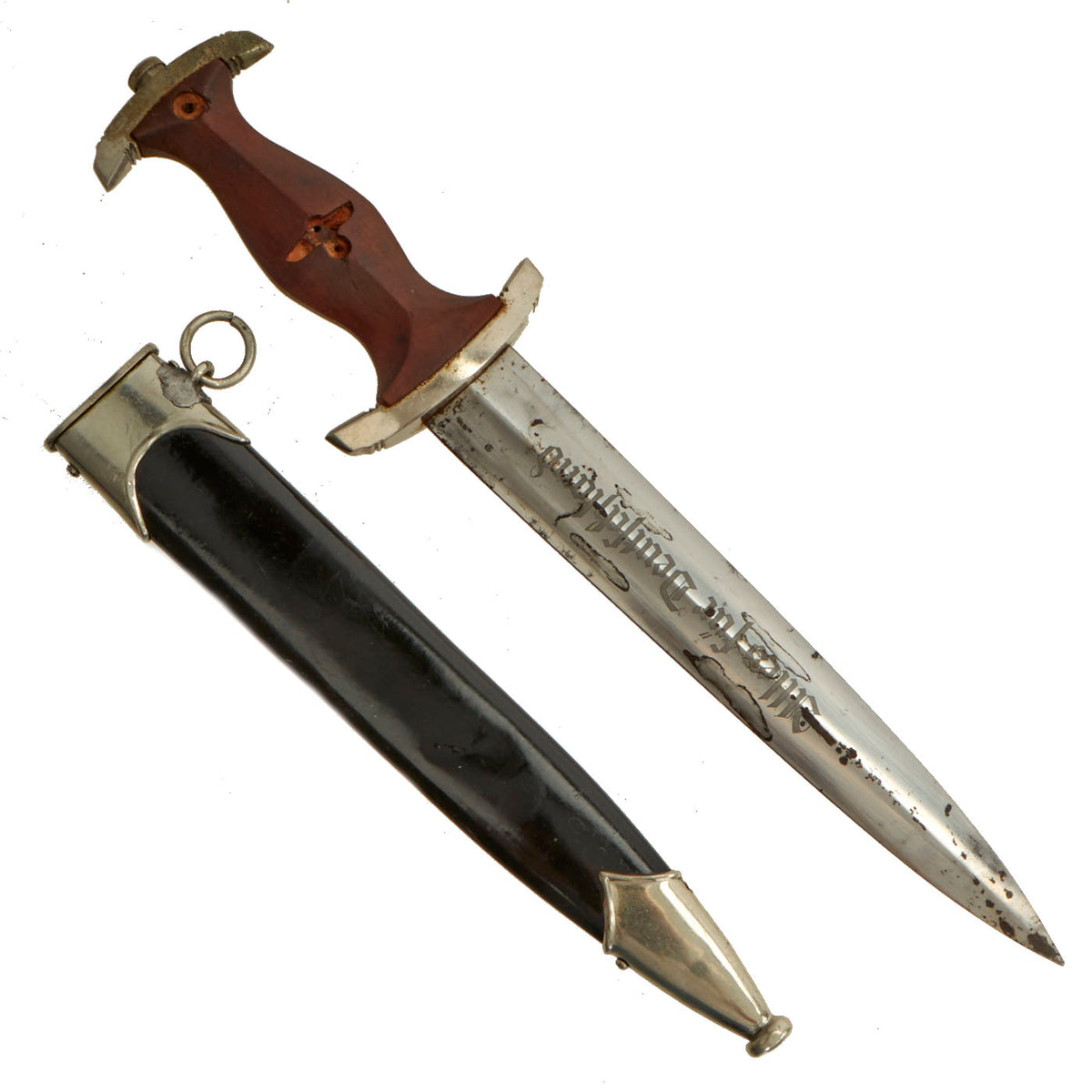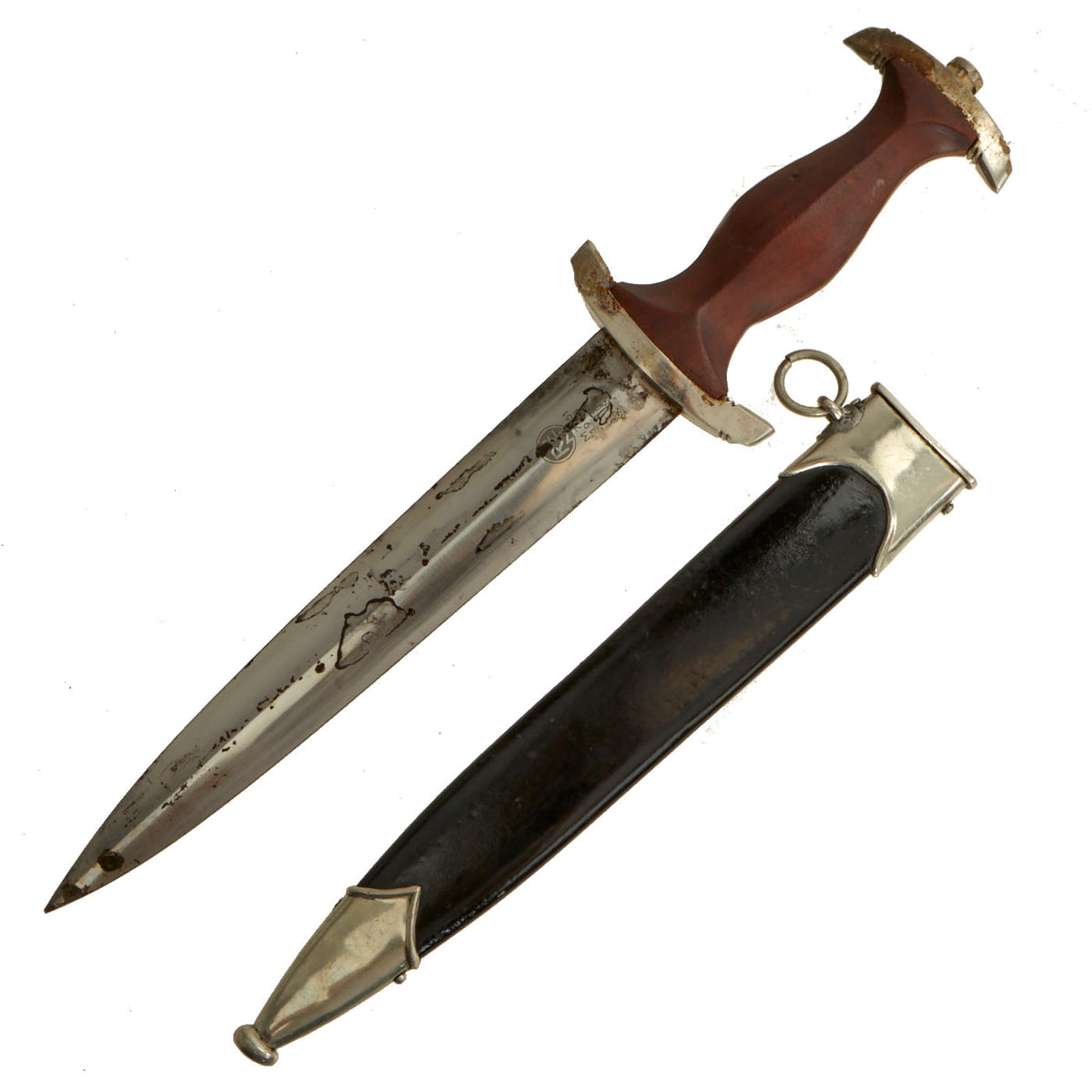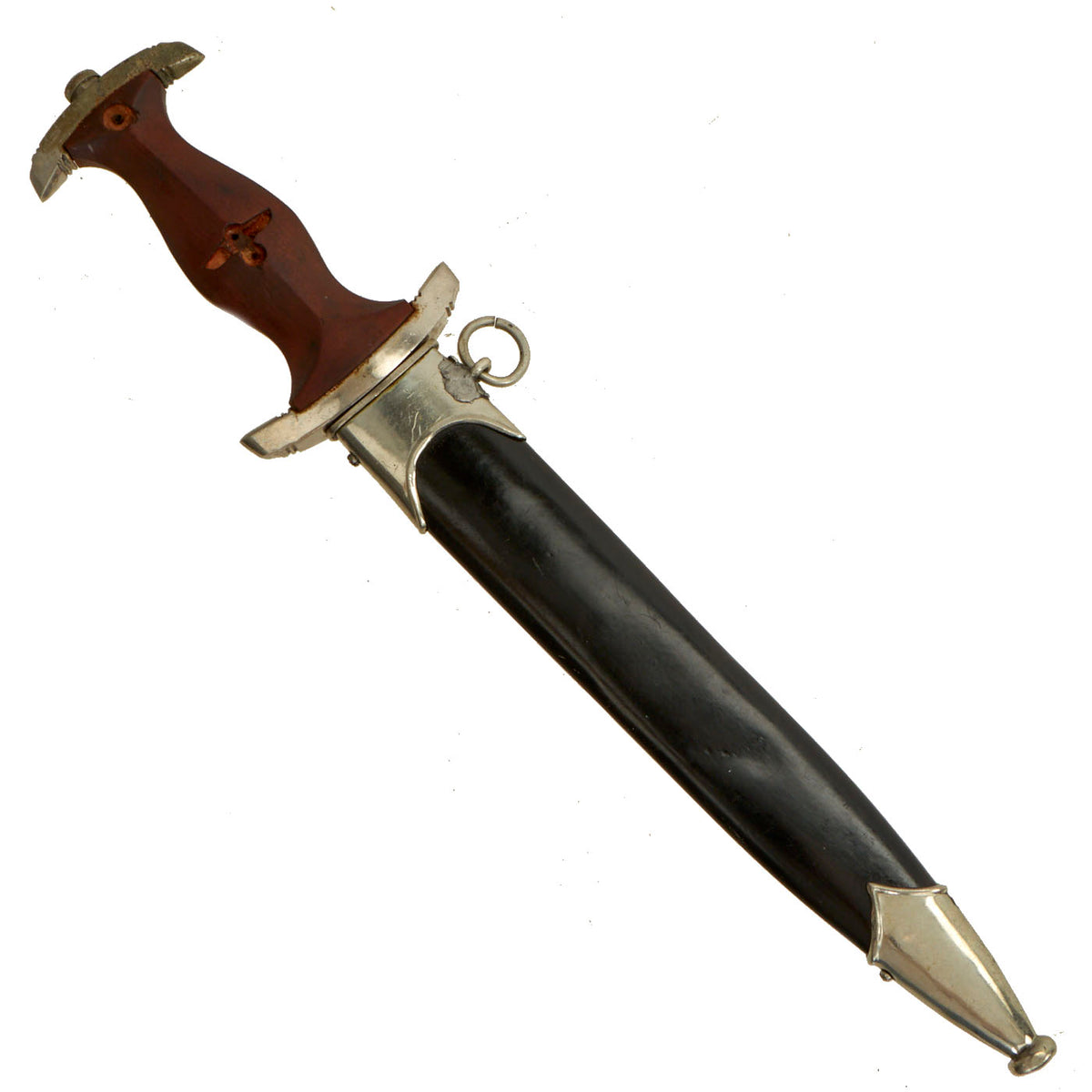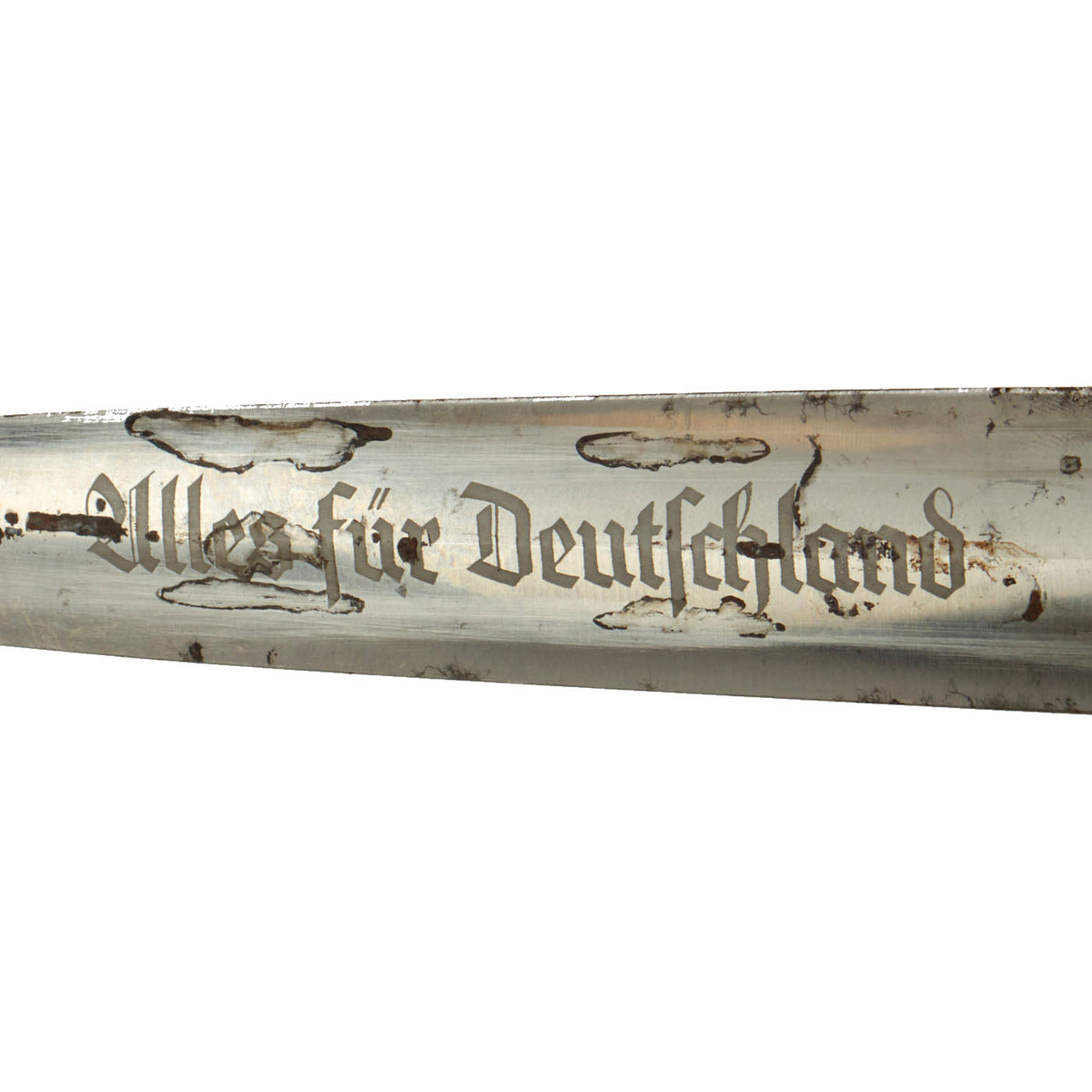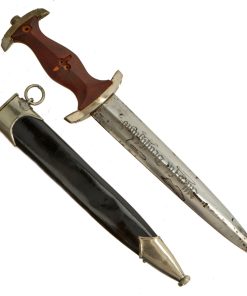Original German WWII “Sanitized” 1938 dated NSKK Dagger by Anton Wingen, Jr. with Scabbard – RZM M7/51 Original Items
$ 295,00 $ 118,00
Original Item: Only One Available. This is a very nice condition early war period produced NSKK Dagger, made by the rare firm of Anton Wingen Jr., Stahlwarenfabrik (Steel Wares Factory), based in Solingen, the legendary “City of Blades” in Western Germany. The dagger has very nice has nickel-plated fittings throughout, typical of the middle production period. Unfortunately, it was “Sanitized” post war, and the eagle and SA insignia on the grip were both removed, though there is still part of the base of one present.
The NSKK daggers are identical to the SA dagger, except they have a black finished scabbard. The crossguards and tang nut are nickel plated alloy, probably zinc or aluminum, and have most of the plating intact, with some overall patination and oxidation. There are areas where the plating has lifted, and overall the fittings look to have bee exposed to moisture.
The grip overall is a bit loose however, due to the wood shrinking over the decades. The wood itself does have a great red brown color, with the usual medium center ridge construction. Aside from missing the insignia, the wood also has some cracking on both sides near the crossguard.
The blade shows a lot of the original factory final polish crossgrain on both sides, however there are also numerous water stains on both sides, some of which have been polished out. The blade does have a sharpened edge, but it is very precise, so it looks to be factory. The acid-etched Alles für Deutschland (Everything for Germany) SA motto is still quite crisp, with a lot of factory darkening still intact, and a bit of oxidation.
This example was made by Anton Wingen, Jr. of Solingen, and the rear is marked with both the RZM contract information and their “Standing Knight” trademark logo :
((RZM))
M7 / 51
1938
(Standing Knight)
Founded in 1888 and registered with Solingen Authorities in 1901, this company first became popular during WWI when their high quality hunting and combat knives became popular with the troops. The company continued operation after WWII, stopping production in 1995, and closing in 1997. They manufactured SA and NSKK daggers during WWII, first with their trademark and later with RZM code M7/51, per J. Anthony Carter’s excellent book GERMAN KNIFE AND SWORD MAKERS.
The scabbard shell is straight throughout, with just a few dents. The fittings are non magnetic, and it looks like this was originally an early pattern scabbard with an “anodized” finish, most likely brown. It was then repainted with black enamel, most likely when the NSKK branched off from the SA. The texture of the original finish can be seen in areas through the black paint. The nickel alloy fittings are in good shape, though the bottom fitting is dented, as they often are.
The Reichszeugmeisterei, or RZM, was was based at the Brown house in Munich and NSDAP party headquarters in Berlin. The RZM ensured that the manufacturers of military items were consistent in design, quality of materials and other characteristics of the items. It also defined standards of design, manufacturing and quality and published an authoritative color chart for textiles. The M7 in the code stands for knives/daggers, contractor 51 stands for firm Anton Wingen, Jr..
A very nice “Sanitized” example of an NSKK dagger from a desirable maker, complete with scabbard. Ready to display!
Specifications:
Blade Length: 8 3/4″
Overall length: 13 3/4”
Crossguard: 3”
Scabbard Length: 10”
History of the SA and NSKK-
The SA or Brown Shirts, were a private political formation which Adolf AH and the NSDAP used to maintain order at organized Party meetings and demonstrations. The group was formed in 1921, and grew to a huge force of nearly 3,000,000 men by the later 1930’s. To instill esprit de corps, as well as create employment for the Blade City of Solingen, it was decided each SA man would carry a dagger with his Brown Shirt uniform. Huge quantities needed to be produced to accommodate the demand. The dagger initially was produced of hand-fitted nickel mounts with attractive finished wood grip and brown anodized (a bluing process) finished scabbard.
The blade was etched with the SA motto, Alles für Deutschland. Examples produced prior to 1935 were stamped with the German sector of the SA group on reverse lower crossguard. Later examples underwent standardization through the RZM ministry. These pieces were produced of cheaper plated zinc-base fittings and scabbards were simply painted brown.
Prior to his “unmasking” as a traitor, Ernst Röhm was the leader of the SA. In 1934, he distributed approximately 100,000 SA daggers with his personal inscription on the reverse blade. These daggers were to honor individuals who had served with the SA prior to December, 1931. Other than the inscription, these pieces were identical to the standard M1933 SA dagger. After the Röhm purge, the inscription was ordered to be removed. Many examples were returned to the factory for grinding. Others were simply ground in the field by whatever means were available. Examples will occasionally be encountered with remnants of the original inscription remaining on the blade, but mostly none will remain. Some blades exist with an intact inscription, reflecting only the removal of the Röhm signature. Very very rarely is an example seen with a full, untouched inscription, as the holder would have surely risked a charge of treason.
After the purge, the NSKK, which had been a part of the SA, was split off into a separate organization. They retained the same daggers as the SA, however now used a black painted scabbard, and their officer’s daggers had a few differences as well. Many already had SA daggers, so these had the scabbards painted black over the original brown anodized finish.
Fast Shipping with Professional Packaging
Thanks to our longstanding association with UPS FedEx DHL, and other major international carriers, we are able to provide a range of shipping options. Our warehouse staff is expertly trained and will wrap your products according to our exact and precise specifications. Prior to shipping, your goods will be thoroughly examined and securely secured. We ship to thousands clients each day across multiple countries. This shows how we're dedicated to be the largest retailer on the internet. Warehouses and distribution centres can be located throughout Europe as well as the USA.
Note: Orders with more than one item will be assigned a processing date depending on the item.
Before shipping before shipping, we'll conduct a thorough inspection of the items you have ordered. Today, the majority of orders will be delivered within 48 hours. The delivery time will be between 3-7 days.
Returns
The stock is dynamic and we cannot completely manage it because multiple stakeholders are involved, including our factory and warehouse. So the actual stock may alter at any time. It's possible that you may not receive your order once the order has been made.
Our policy is valid for a period of 30 days. If you don't receive the product within 30 days, we are not able to issue a refund or an exchange.
You can only return an item if it is unused and in the same state as the day you received it. You must have the item in its original packaging.
Related products
Uncategorized
Uncategorized
Uncategorized
Australian WWII Owen MK1 Machine Carbine SMG Custom Fabricated Replica with Sling Original Items
Uncategorized
Uncategorized
Armoured Fighting Vehicles of the World: AFVs of World War One (Hardcover Book) New Made Items
Uncategorized
Uncategorized
Uncategorized
Uncategorized
Angolan Rebel 1970s era 60mm Inert Display Mortar from Angolan Civil War Original Items
Uncategorized
Uncategorized
Uncategorized
Uncategorized
Uncategorized
Armored Burgonet Helmet & Polearm from Scottish Castle Leith Hall Circa 1700 Original Items
Uncategorized
Uncategorized
Band of Brothers ORIGINAL GERMAN WWII Le. F.H. 18 10.5cm ARTILLERY PIECE Original Items
Uncategorized
